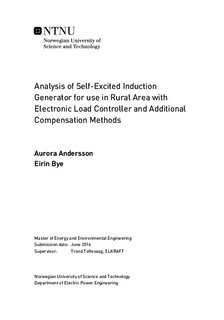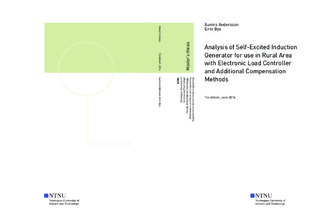| dc.description.abstract | The objective of this thesis is to provide a throughout analysis of the possible use of an induction generator in isolated operation in rural area, using the principles of electronic load control to maintain stable operation. The requirements given are based on local conditions, where the SEIG is intended to operate to provide basic electricity supply for people living far away from a centralized grid connection.
A theoretical description of the challenges related to operation of an induction generator in isolated mode is given, providing knowledge about what a control system for this purpose have to take into consideration. The main challenge is all the mutually dependant parameters, and the difficulty to determine their relations when no parameter can be assumed 100 \% constant. The relations of highest importance in the investigations presented in this thesis is the dependency between voltage level, reactive power balance and frequency.
Possible options for load controller design and alternatives for reactive power compensation are studied, and presented in view of given system requirements. Since it is the request from Remote Hydrolight to investigate the possibility of using their existing triac controlled technology with SEIG, it is used as a reference case when both a simulation model and a laboratory set-up is built based on knowledge gained in the literature study. The main drawback to the triac solution is its consumption of reactive power, which results in a voltage drop. Based on the theory, this voltage drop was expected to be severe. Simulation and laboratory results is however more promising, and the triac solution might be used without compensation for the case of controlling only resistive loads. A second option for ELC, the uncontrolled rectifier using chopper controlled dump load, is also implemented in a simulation model. The latter showed the best voltage regulation, but the triac solution had better voltage waveforms and less THDs [\%] measured.
When simulating different ratings of load size it was discovered that the SEIG system seems to be more vulnerable for changes in reactive power if the total load is small compared to the rating of the generator. A shortage of reactive power might be a more sensitive issue at this operation point, which is something to take into consideration when designing the ratings of the power system.
The connection of an induction motor as a load is the most likely "worst case"-scenario of load connection in a system like the one studied, and this is used as a scenario for testing possible reactive compensation methods in both lab and simulations. In all cases the connection results in a severe voltage drop caused by the inrush current and reactive power consumption. A too high ratio of motor size versus generator results in total voltage collapse. Some type of compensation will be necessary in order to maintain system voltage during connection of a motor.
Of the reactive compensation options studied, the switched capacitor has the most potential. The quality of the voltage regulation provided by this unit depends on the amount of capacitors connected. This is again affecting on the total costs. As the inductive load in the system is most likely an IM, a small number of capacitors can be used dimensioned to match typical IM sizes. If this solution does not provide desired voltage levels, a slight increase or reduction in frequency can be used to further adjust the voltage level. Increased frequency was used as a method to provide rated voltage at loading conditions with increased reactive power consumption. It was found possible to maintain the voltage measured at the village load within given limits even when the IM was connected, and at the same time keeping the frequency within given limits as well.
As a final recommendation to Remote Hydrolight, it is stated that the triac ELC can most likely be used without compensation given only resistive load. For the case of sudden connection of inductive loads like an IM, a combination of switched capacitor and small adjustments in frequency is suggested. | |

